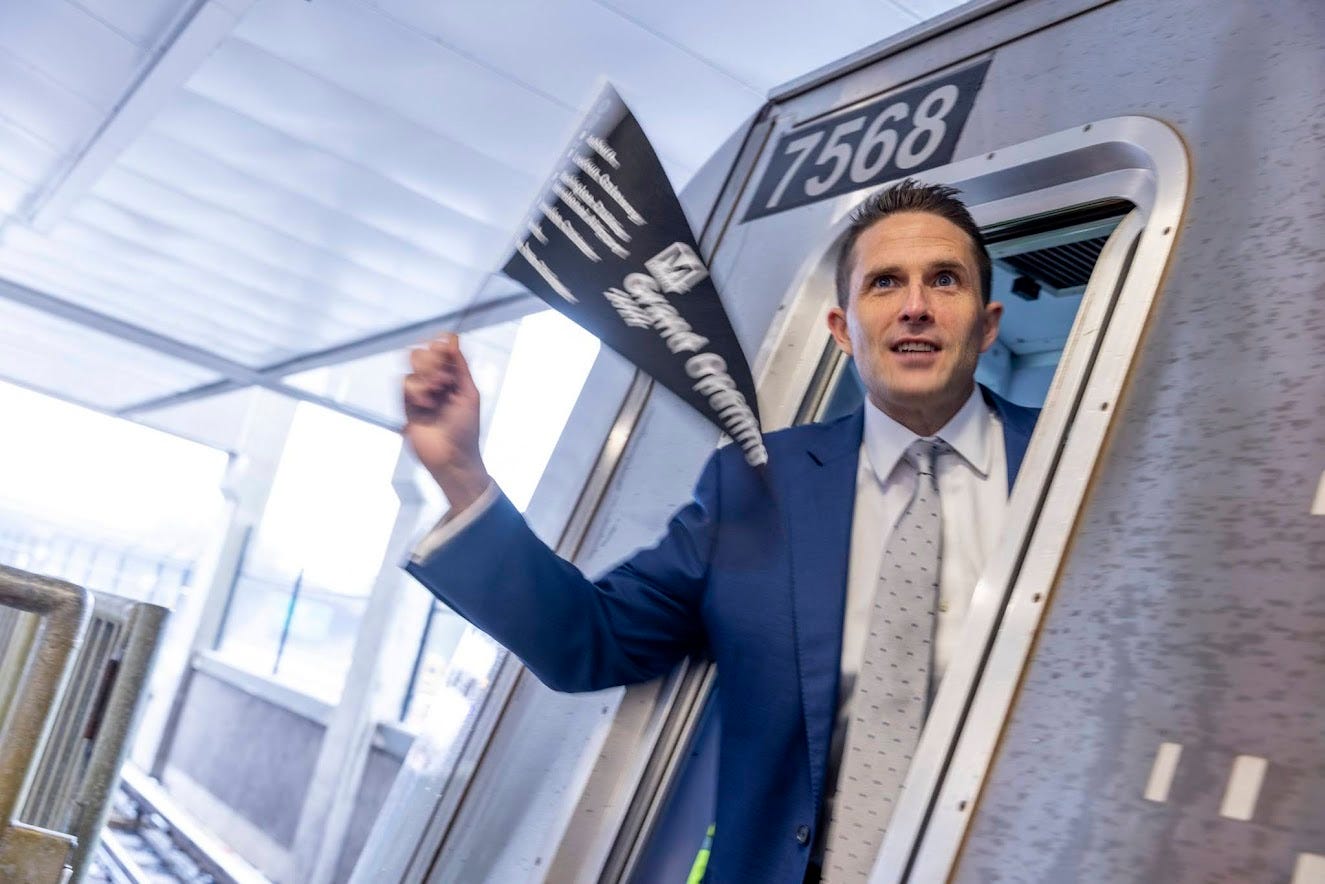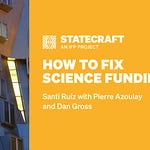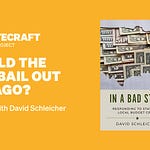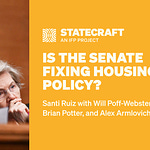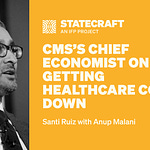Today we talked to Randy Clarke, the head of DC’s Metro system, WMATA. If you’re a transit nerd, you probably know about Clarke — he’s become something of a celebrity for his public presence and disciplined improvement of a transit system that was facing disaster in the aftermath of COVID (and the decision to allow large swathes of federal employees to work from home).
I’ve been a regular WMATA rider for long periods of my life, and what Clarke has done over the last three years has been pretty remarkable. We’ll get into some of the details here, but what stands out to me — and why I so wanted to record this conversation — is that Clarke’s managed to advance a bunch of his priorities at once. From the outside, it can seem like he hasn’t had to make any tradeoffs at all: between safety and speed, catching fare evaders and keeping costs down, etc. How has he pulled it off?
We get into it here, in what is (I think! Correct me if I’m wrong) the most comprehensive interview for a mass audience Clarke has done in years.
Before we get into the substantive questions, I should mention that my family lives on the Orange Line. I live in New York, but when I'm in DC, I'm a regular Orange & Red Line commuter.
Excellent. That's good to hear. The Orange Line, known back in the day — and kind of coming back — as “Orange Crush.”
Is that right? I'm out of the loop.
Yes, so many people take the Orange Line, and with rush hour these days we're starting to feel a little bit of that Orange Crush coming back.
Since you became the head of Washington Metro in 2022, you've done a whole lot — increased speeds, reduced fare jumping, increased ridership, increased safety. You’re rolling out tap-to-pay with credit cards.
Often, when I talk to other political leaders, they emphasize the importance of trade-offs in prioritizing — “You can't have everything.” You’ve said you have to prioritize service and frequency over other things, but you've managed to get through a long list of achievements under some tight budget constraints. Have you had to make hard choices? How do you think about prioritization?
Listen, that's the ultimate in public policy, right? It's not just transit, it's everything. Trade-offs are the thing that's hard: prioritization and having the discipline around that.
When you say frequency is the thing I prioritize the most — yes, except that safety, to me, is not a trade-off. Safety is an absolute and a core value, and then you add from that. I want to make sure I initially say that because I don't want someone retweeting later to say, “You care about frequency and not safety.” If we're running service, it has to be safe. After that, you need to have frequency and reliability.
I am worried that we get caught up in a lot of other things that don't move the needle. Frequency and reliability in transit are the most important things, and they're not even close to anything else. We have a lot of marketing and amenities, and they're all important, but they all end up being additive to just really good service. That's what we're laser-focused on — from the second someone enters a bus to getting off a bus or entering a station. Whether it's an escalator working well, good customer service, the fare gates working well, great signs that tell you when the next train or bus is coming, train doors working, air conditioning working, good announcements, etc.
Honestly, it sounds weird, but we want you in and out as fast as possible. The best customer service for us is in and out. Your time is the most important thing in your life, and when we can give you more time back in life, that is a massive value-add to society.
Sure. But I could imagine somebody coming in your shoes in 2022 and saying, “After safety, we're going to have a ruthless focus on frequency. That's going to be our gold standard, and to that end, we are going to set aside some of the nice-to-haves: the whole customer service experience. We’re not going to worry about fare jumping right now, because that's another priority that could get in our way.”
That is not the approach you've taken. How have you gotten so much done, given your prioritization?
You have to sacrifice a lot of the rest of your life, a little bit, which is sad, in different ways. You have to surround yourself with great people. I'm really lucky — we have a great team here. We have a good board that really cares about the organization. We have a strategic plan that the board approved, so we have to focus around that. That helps get rid of some other distractions.
But to me, we came in as a — I don't want to say shotgun, because that might make people think it wasn't focused — but a focused shotgun. So we knew we had X amount of things.
Summer 2022, when I got here, people forget that we were not running train service, really. Our 7000 series trains were grounded. In a lot of ways, that was priority one. We had to get our trains back. But next to that, we had some safety issues in the system. I don't mean necessarily system safety — I mean public safety. We had serious crime in this region. We had way too much crime. I think we had six homicides in my first year — there were shootings, there were stabbings.
Right now, we have a seven-year low in crime on the system, and we're on pace for the lowest crime year in the history of Metro. For fare gates — we had to get the law changed in D.C. We had to up our police presence, we had to get special police in here, we had to fix our video systems.
What we've done is taken a group of people and been able to really drive collaboration and teamwork. My first week, I told everyone, “Back in the office.” A lot of people didn't love that at the time. I think that is actually one of the reasons we produced so much.
The other thing is, I’m just a no-nonsense kind of person. I love the people I work with, but I'm not in for a lot of delay in making decisions. Decisions are never going to be perfect, and the key is: do your trade-offs, cost-benefit, let's go back and forth. But time, in one way, is the most important thing we’ve got — especially the higher up you get in the organization — to make decisions and then help give the people below them the chance to be empowered and move things forward.
So I think what we've done is a relentless pursuit of the customer experience, and then we'll figure out the bigger stuff. Now we’re just getting to that, which is this long-term vision of full automation of our system, a massive regional bus push: Some of these other things that we would never have been able to do if we couldn't have gotten the bread and butter back to where it needed to be.
Before we move on, I want to go back to the relationship between public safety and your successful crackdown on fare evasion.
You’ve installed new fare gates — they’re much higher and trickier to jump over — and have coordinated aggressively with police. How much does the crackdown on fare evasion have to do with improved public safety on Washington Metro?
I'm not sure I could give it a percent or a grade. In one way, it's very significant, but in another way, it's partial, and I know that sounds weird to say. There is some truth to a larger societal idea: people want to see other people follow rules, and the more that people follow rules, the more people watching them follow rules. If you watch someone get on a bus and there's a line of five people, and the first person pays, most everyone pays. If the first person doesn't, a lot of people don’t. It creates almost an ability for people to say, "Well, I didn't know," or "I thought it was broken," or whatever. There's a societal groupthink at play.
The second part is — and we were very clear — not everyone who fare-evades commits crimes, but almost universally, everyone who commits serious crimes fare-evades. Not many people are going to tap in and then do armed robbery. It's just not generally the same people who do that. And, if you were smart enough, you would not have the evidence that you tapped in.
Now mind you, we're watching with 30-plus thousand cameras, so you're going to get caught anyway. But I really do think it has had a big impact on serious crimes.
Then, you add in all of the layers of security: we have police walking trains and platforms, bus inspection teams — we brought the police bus unit back — and video. We are being very transparent. Last week, we had a day with a bunch of fare enforcement. We had six or seven people arrested for failure to appear or justice outstanding warrants, with two guns off the system. We talk about that, and that further brings deterrence to the system.
So I would say it is a multifaceted approach, but fare enforcement was certainly a significant element.
The other thing is, it creates the revenue we can use to go do stuff. I think that's lost on people. I know a lot of people go, "No, no, no, everything should be free." Well, great — that's a larger public policy conversation, but right now it's not. The money that people pay — those user fees — are incredibly important, especially in large agencies like Metro, to run the system, to have frequent, safe, reliable service, but also to have police officers and station managers and gates work.
Will you give me a back-of-the-napkin calculation of how much revenue WMATA generates from cracking down on fair evasion?
Listen, the hardest part is there's not a one-to-one correlation. There is an obvious trend or comparison: where we've cracked down, we're getting more revenue. But again, is it the gates? Is it the police? Is it the deterrence campaign? Is it a ridership increase? We also increased fares last year. We're getting more people from larger distances vs. short. We were losing tens of millions of dollars in revenue, and we've quickly gained back tens of millions of dollars in revenue. So there is clearly a pretty good connection there, but it's really hard to say, “All of our efforts around fare enforcement this year led to $27 million.” But it's certainly, I would think, tens of millions of dollars gained back for the system in the last year. There's still tens of millions left, especially on the bus side.
Well, maybe you'll give the same answer to this question, but I'm curious. You’ve had 50 months of increased month-over-month ridership, which is fantastic.
How much of that you can chalk up to people who were riding anyway but weren't paying, and now you're measuring their rides because they're paying?
Again, what we really have is the ability to track fare evasion rates then vs. now. We believe that since two summers ago, we've reduced fare evasion on the rail side generally somewhere between 82–85% on the system. That is a pretty significant change.
On the bus system, we are seeing change, but nowhere near that. It's just so much harder to actually do, for obvious reasons. We left it too long here as an agency for so many years. It's hard to put the genie back in the bottle, but we're working on that really hard. The more everyone sees everyone pay, the more the anomalies stick out, it's easier to enforce, and that further reduces it even more.
Washington Metro has more or less $5 billion to spend over the coming fiscal year. What will that go to? And then I want to talk about where that money comes from.
Sure, $2.5 billion on operating, $2.5 billion on capital, generally speaking.
Break that down a little further for me.
The operating side pays for service, more or less. That’s MetroAccess, bus service, rail service. Then obviously all the administrative services — accounting, human capital, IT — all of the back-of-house stuff to support that. Police is in there too.
On the capital side, it’s everything from State of Good Repair — wonky term — to what’s called modernization: things like replacing escalators, replacing track every day of the year, replacing signaling systems, rail and bus rehab, that kind of stuff. Basically, making sure the house itself works.
We have a little bit on planning, but uniquely for an agency, we have nothing in design or in construction: no new line, new station, new extension. Our capital side is $2.5 billion to take the assets we have and modernize them.
Tell me about that. You mentioned it's pretty unique not to have any new lines in construction. I'm guessing it's easier to manage the transit authority when you’ve got no major new projects outstanding?
I wouldn't say that at all, actually. I think it's hard to deliver a capital program when you don't have a big Goliath that sucks up a lot of the money and focus. You have to execute really well across a thousand things, instead of a couple things and one big thing.
There's added pressure. It's easy to complain about that one escalator project, or this power upgrade at a power substation. But the reality is the basic stuff is the most important stuff, all the time. We've lost our way a little bit — not to get too crazy here, on my policy soapbox — but we've really turned into a ribbon-cutting society on everything.
Like Twitter announcements — don’t get me wrong, I do a lot of this kind of stuff, and I think you should do it. It’s super important that we sell the value of government and of great public institutions and assets that are community-focused, and take accountability when they're not. But the little stuff is the big stuff when it's put all together.
But in a lot of ways, the system is hard to run. The big stuff is really complex. Everything in society is complex to do now, because everyone — let's be honest — everyone thinks they can do it very well, and it's also very hard to understand cost management in a world that is, I won't say completely out of control, but very hard to really do forecasting on revenues or expenses with the way the world's going right now.
Before we keep going, I'm getting some background noise.
That is a train running behind me! The back of my office is the main line of CSX, VRE, and Amtrak. I can see from the reflection of the window that there is a big heavy freight CSX train running behind me right now.
Fantastic. Okay, then I'll keep that in as local color.
Let me ask you about the politics of maintenance vs. big new ribbon-cutting projects. I've heard from other folks we've interviewed in this series — Stephanie Pollack, Peter Rogoff — that it tends to be more difficult to get politicians and state legislatures to pony up for maintenance than it is to sell them on a big new project.
Has that been true in your experience?
Yeah. I think in a lot of places that's true. I've worked at the Boston system, that’s how I know Stephanie; Cap Metro, and then here.
Here, it’s not as much of an issue because Metro went through an incredibly difficult time in the 2000s — derailments, fire issues. The infrastructure was crumbling because we didn’t really have a preventive maintenance program.
What do you mean, you didn't have a preventive maintenance program?
Well, I think this place got built very much like, “Hey, here’s this beautiful system, we’re going to build it all.” But this place has no dedicated funding. So we go to three jurisdictions — D.C., Maryland, Virginia — every year, plus the feds. We need to annually go to each state and make sure our operating budget is going to get funded.
No one historically has ever wanted Metro to have its own funding, to do its own planning and be accountable for that. That leads to not having a really significant amount of money for State of Good Repair modernization, which has led to a couple of crises. So there's a crisis at one point — here’s some money — then it goes away. As the system grew, it was not funded proportionally to do the maintenance in a level of good enough quality.
So you get into the early 2000s and the age showed. We started having insulator fires on the track multiple times a day, ventilation problems, train problems, and just on and on and on.
This region really learned that the hard way. Someone died in 2015 in a bad incident — and the deterioration of the asset base really shocked the region. So in one way, getting funding for maintenance here is probably easier than most places because of what happened. That death led to a lot of funding driven in 2019, and that was really important, but the problem was that funding was not indexed. There's no growth in it.
$500 million is a lot of money — there’s no getting around that. But $500 million today is not 2019’s $500 million, and it’s certainly not going to be the same in 2035. We’ve been working on this big initiative for all the regional electeds and our board and others. We have almost everyone unified that that was a failure — not because of any individual person, just from poor governance and regionalism. Now people want to baseline that number and drive it in an indexed way going forward, so we don’t repeat that mistake.
I think there is a maturity level here. Part of what’s unique in the D.C. market is that we are the wonkiest of wonk towns. The amount of people that understand things — and that’s not to say other towns don’t have smart people — but here, we analyze. Whereas if you’re in other markets, most people don’t care about maintenance at all.
Let’s be honest — most elected officials are incentivized within a two-year congressional cycle or a mayor or something else — to constantly do new things, right? They’re not incentivized to say, “Hey, great, the elevator at Vienna Metro Station is going to have an uptime of 98.8% vs. 92%.” Most people are not going to win the election on that. But they do like saying, “Hey, we’re going to add two more stops to the extension.”
But I think that also the challenge is some economic headwinds right now.
Let me ask you about financial projections. A couple years ago, Metro was in a really big financial hole, to the tune of $750 million.
It's smaller now, but you're still running at a deficit. What would have to happen for Metro to be on a sustainable financial trajectory 10 years from now?
Yeah, that’s why we created this thing called DMV Moves. It's the Council of Governments and the WMATA board — we formed a task force. It's mostly elected officials around the region. We've been meeting for over a year. We're going to wrap it up in the fall.
We got everyone grounded around this problem statement I just mentioned. And we want to really modernize our system — go to a fully automated rail system and some things of that nature, better big investment in regional buses.
So on the operating side, we've actually — I don't want to say we resolved it — but we feel pretty good about maybe going forward at Metro. We got an influx of some money from our three state partners last year — not enough — but call it $400-some million. Metro then took it on its own to save a fair amount. In the last two and a half years, we've identified $500 million of cost savings or cost avoidance, which is both operating and capital. That’s a huge amount of money.
That includes every employee at this organization who took no merit increase last year, including all of our unions, which is a big deal. That alone was worth, I think, $38 million, as an example. But everything from trimming some consultant stuff to IT stuff and just doing business a little bit smarter.
Then revenues have also gone well with ridership increase, and we did a fare increase last year. I think what we need to do is, every three years, a fare increase that's inflationary — so it’s not big, but it keeps people aligned. Then Metro has to live within our means, right? If we say it’s X, then we have to live within that and not just have a handout. But we need alignment with the region so that everyone knows what you get for that money.
The capital side for us is the big issue. So in 2029, we have projected that we’re going to run out of debt service financing, and that’s going to drop our capital program probably by $600–800 million in one year, maybe more. So that is the big effort: to make sure — ideally next year, because capital programs take years to plan out — that we have that continuous funding.
And for the first time ever, we get into a revolving bond program. That means we self-finance. So as our bonds expire — 20 years, 30, 40 — you know, then we rotate into new bonds. That way, we never have a problem with maintaining the structure of this organization going forward.
What would have to be true financially for Metro to seriously consider building a big new line or an extension? You guys have ideas about the Georgetown Blue Line, other models in the works — what would have to be the baseline state of play for that to begin?
We had this idea, this Bloop thing that's been kicked around for a lot of time.
Will you just explain the Bloop for those of us who are not DC natives?
The Bloop stands for Blue Loop. We didn't call it that, but the local advocates came up with that.
Our number one issue here on the rail side is that the system was built with a good chunk of interlining. Interlining, for our readers, is multiple lines coming together and sharing tracks in a section. Some agencies have that set up that way, and some don't. New York has a fair amount of interlining. We have a bunch of interlining. The difference in New York is they have local and express tracks, and we don't have that. In Boston, there is no interlining — all the lines are separate.
For us, the biggest challenge is a place called Rosslyn, and it’s the first stop in Virginia on the Blue, Orange, and Silver lines, which we call BOS. From that location, to Stadium-Armory, the far eastern end of the Blue, Orange, and Silver lines, the BOS lines run together, and then they branch. We have a capacity issue in that section, which is basically across DC and partially into Virginia. We need to solve that capacity issue long-term. At the same time, our signaling system is 1960s–70s technology — a good analogy is the air traffic control system, quite frankly. It needs massive modernization.
Instead of building a new line, we've got some analysis work that, instead, we want to modernize our system very significantly and go to a fully automated rail system like you'd see in Europe and Asia. By doing that, we will solve all of the capacity needs going through the system. But we'll also get our reliability up to the 98–99% range all the time and significantly increase safety because it's now modernized, and become incredibly cost-efficient because, at the end of the day, your cost to run a level four automation compared to level two or manual is dramatically lower.
That is where our number one focus is — how to move the rail system to CBTC, which is “communication-based train control,” with platform screen doors, and a fully automated rail system. That doesn't mean no employees, by the way — I'm not suggesting that for one minute. It means different types of skills and different types of roles. But a system equivalent is your local Dulles Airport (IAD), which has the people mover — same kind of feel and situation.
After that, there's clearly some potential need for some more infill stations. Some people want to do some extensions. We need to have a big conversation about extensions — where they really need to be versus political, where people want them to be. The land use needs to be the right land use to drive that extension, either currently or by law to force the land use to be productive for that type of heavy rail investment.
When you say productive land use here, you specifically mean a lot of people living along those lines?
A lot of people living there, or activity centers. You shouldn’t be building any rail system with that kind of cost to a single-family cul-de-sac, for obvious reasons.
What we need is density and activity centers, so people can live their lives with a significantly smaller transportation cost footprint, and it drives the value of that investment. There's also some infill stations. We also want to do some BRT. There's crazy big things happening around this region, right? You know, RFK and the Commanders — massive chance to redo 175 acres at RFK, new stadium. How do we fit into that puzzle? There’s conversations going on there.
We have two second entrance projects going on right now. We're going to announce another one coming up as early as next week. There's a lot going on here, but to me, the biggest focus — and I think for me as a leader, and the team, and the board — is: How do we do the old Athenian code — leave this place much better than when we got it? And one of those things is making sure a system that is starting to age is left in a much more modern way.
You mentioned cutting back on consultants as part of WMATA’s cost savings. In an interview a couple of months ago, you talked about the “consultant-industrial complex.” Can you tell readers:
A) What you mean by that, and
B) When you cut back on consultants, what contracts are you doing away with? What are you bringing in-house?
Yeah, I think I actually framed that as the "transit-industrial complex," because consultants are an important part of our industry. [NB: Axios quoted Clarke as saying “the consultant-industrial complex.”] I have many friends who work there — hey, I’ll need a job one day! Listen, the consultants do really good work. I think the key here is — and I think all the consultants say the same thing — we should be using consultants for A) staff augmentation for a period of time until we ramp up the thing we need, or B) a very specialized thing that we do not want to do in-house, or for a timeframe where it’s just not valuable to do in-house.
What we should not do is hire consultants and have the same firm doing the work 18 years later that we should have just in-housed. The second thing is, our industry is so risk-averse that we generally hire people — internally or consultants or whatever — to constantly do analysis. Let’s be honest, there's a lot of people who like to do butt-covering. And that's not because of them as individuals — it’s our incentivized structure, or rather, our disincentivized structure, all the way from the federal government to governors, to mayors, to boards, to executives. Right? No one in our society really wants to be blamed for something. So you keep adding layers.
It’s why we end up where — You know, there's this big fad now. I joke, I've been talking about this abundance stuff my entire life. Now, I screwed up: I should have written a book, apparently, because you can make millions of dollars explaining to people that it’s just normal to build stuff. We've created so much lasagna that it's impossible to get a lot of stuff done.
That's what I mean by that. Most people actually all want the same outcome. To me, we have to be able to think through risks differently. The risk of not doing something is not usually thought of, compared to how we analyze the thing that we are doing. The opportunity cost really hurts us as a society — not building homes, not building better infrastructure.
I think most readers will be fans of that at the high level. Can you drill down a little bit and talk about the pieces of that lasagna — about those sets of demands you experience at Washington Metro? Give us a concrete example here.
How we do safety thought processes, right? Yes, we could get hit with a Category 5 hurricane. We're probably not going to, so how do we think about that? We had a project when I got here thinking about solar panels on a garage, and we spent so much time and energy worrying about them getting ripped up in a Cat 5 hurricane — which, by the way, the whole building would be basically gone in one of those.
We had bus shelters designed to basically get hit — literally, part of the idea was if they get hit by a huge truck, they could survive. We were spending like 8x more to build a bus shelter.
My whole thought is, well, if it gets hit — which we only have a few a year — just put a new one up. We’re building a bus shelter to be good for like 50 years. But the cost difference of just doing one and then replacing a couple times took us from like $400-and-some-thousand dollars for a bus shelter to like $80 [thousand].
Where was that pressure to truck-proof them coming from?
I think just culture for a long time. Everyone has their say in something, and then by nature, everyone’s going to want their thing to be the thing — “Well, I can’t have that come back on me, or I don’t have the maintenance assets later to deal with it,” or what if this or what if that.
When everyone in an organization adds risk, when you get to the end, you have the lasagna. That’s what I mean by lasagna, right? The first layer is not that big of a deal. Seventeen layers later, you’re like, “Oh my God, how did we get here?”
No one is being actively bad or malicious. But as leaders, we have to be willing to create the framework for people. I go out of my way on my team to say, “I’m encouraging you to take more risk.” Now, we’re not going to change, like, track gauge. The trains would fall off and people would die. That’s not a smart risk.
But technology — we procure technology in our world like we’re procuring a station. We have to be more nimble, more agile about how we do software. By the time you do a procurement, the software version’s already changed. We need to get more outcome-focused on procurement vs. being more specific. Whereas if we have a concrete mix, that might be more specific because of the weight rating you’re trying to do.
No place in the world has oversight like ours, because of where we are. If the same issue happened in Chicago or San Diego, it would just go on. Here? Front page of the Washington Post, all over Twitter. Everyone in the world that lives here rides our system.
We have three states that are doing oversight. We have GAO, we have FTA, we have USDOT, The White House, NTSB, we have our own OIG. So when you put all that together, culturally, most people will always work toward covering themselves. Again, not in a bad way, because there’s going to be an audit finding.
What I try to get people to think about is: if we don’t have any audit findings at all, we probably have buttoned up too hard. The key is, we don’t want significant audit findings that are true failures. If someone found that we missed an extra copy of an email in a folder — that’s different from someone intentionally committing fraud or malfeasance or things like that.
That’s balancing the risk a little bit. So just trying to give our staff the ability to say “what’s the right way to go about stuff?” Not, “We did this in 1995 this way,” because in 1995 it might have been the right way. But in 2025, say with video or AI or other things, we could do things differently.
Give me one example of a consultant relationship Washington Metro had that you guys got rid of to save money.
I'm not going to get involved in individual consultants — I would never do that, because that might sound like someone wasn't doing something right.
We have an enormous amount of consultant help here. they're team players. They're part of our team. So we might have skinnied this down over here, or we might have said, "You know what? We did this for three years, now let's in-house this."
Okay, you don't have to name names, but what kinds of things might you want to bring in-house?
We did some community engagement, marketing stuff that, quite frankly, is better in-house because it's part of our DNA. Some staff aug that we had on some project controls and other things — just general project management — I think we've rebalanced that a tad. It's a little bit everywhere.
We will always have consultants. Consultants are very important for certain things. But I also want very good staff to feel like they have the ball and they're responsible for things.




